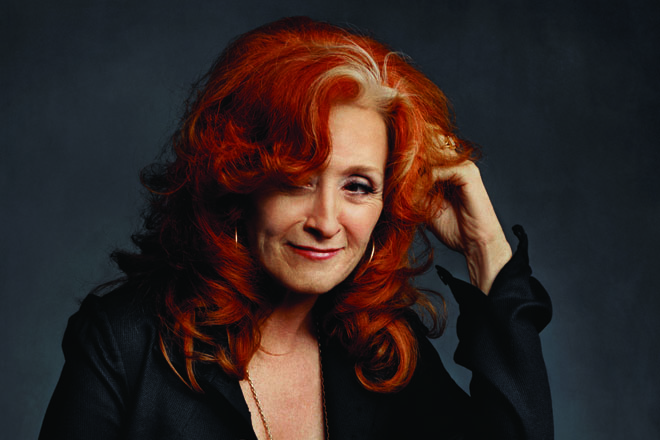Bonnie Raitt
One of music’s most beloved icons slides back into the rock ’n’ roll slipstream.
Bonnie Raitt is always listening. “My ear’s always cocked for a possible direction,” she says. “Something that’s inspirational, either a song I want to do or a songwriter I want to investigate further. We’ve got hundreds of CDs in our collection and files on our computer. I take songs with me on my iPhone and listen every day when I go for hikes. I listen in my car, I’m listening while I’m doing the dishes. It’s like treasure hunting.”
Raitt’s skills as a singer, songwriter and guitarist are unquestionable—her sly, keening slide-guitar solos and warm, inviting vocals are two of popular music’s most recognizable sounds. But her keen instinct for hunting treasure shouldn’t be underestimated. Among the previously buried gems she has turned into hits are John Hiatt’s “Thing Called Love,” Bonnie Hayes’ “Have a Heart,” Paul Brady’s “Not the Only One,” Shirley Eikhard’s “Something to Talk About,” “Little” Jimmy Scott’s “Love Sneakin’ up on You” and David Gray’s “Silver Lining.” “I Can’t Make You Love Me” was an unknown tune by Nashville songwriters Mike Reid and Allen Shamblin when she found it; today it’s a pop standard recorded by everyone from Prince to Adele. “It’s work to find them,” Raitt says. “But it’s a joy when you’ve uncovered the ones that are just right.”
It’s a talent heard in full on Slipstream, Raitt’s 16th studio effort and first since 2005. The previous years had seen Raitt keeping up a heavy touring schedule while coping with the deaths of both her parents—Broadway singer John Raitt and pianist Marjorie Goddard, who had divorced in 1970—as well as her brother, Steve Raitt. “For most of 2010 I decided to unplug and get in touch with some of the other aspects of my life,” she says. “I’d had a lot of loss and illness, so it was good to be able to stay in one place and deal with that.”
She emerged from that time off ready to try something new. Raitt called producer Joe Henry who had recently helmed albums for her friends Allen Toussaint and Mose Allison. Recording at Henry’s home studio with a backing group that featured master jazz guitarist Bill Frisell, Raitt swiftly cut almost an album’s worth of material. She then regrouped with her faithful studio and touring band, including bass player James “Hutch” Hutchinson, drummer Ricky Fataar, guitarist George Marinelli and new keyboardist Mike Finnigan, and headed into Ocean Way studios in Hollywood to cut more tracks. There Raitt acted as producer on a batch of more uptempo numbers, including a cover of Gerry Rafferty’s 1978 hit “Right Down the Line.”
Slipstream combines eight cuts from Ocean Way and four from Henry’s house into a blend of rock, pop, reggae, blues and R&B that is instantly familiar as Raitt’s unique territory. It’s a plot of musical ground she has been steadily refining and expanding since her 1971 self-titled debut, recorded when she was a 21-year-old California girl rocking East Coast clubs alongside blues legends like Sippie Wallace and Howlin’ Wolf. “People say, ‘How did you get into blues, being the daughter of a Broadway singer and living in Los Angeles?’” she notes. “It’s not geographic, it’s not racial, it’s not economic. If it speaks to you, it’s almost like it’s recalling something in your DNA. You get it so bad, it’s in you and it’s got to come out.”
That it did, over a course of albums that found her piling up critical acclaim but attracting little interest from the mainstream. Her astounding second act came in the late 1980s, when a newly sober Raitt launched a collaboration with producer Don Was that produced a series of multiplatinum albums stretching from 1989’s Nick of Time through 1994’s Longing in Their Hearts. She followed up by digging into grittier fare with producers Mitchell Froom and Tchad Blake on albums like 1998’s Fundamental, 2002’s Silver Lining and 2005’s Souls Alike. The latter was her final album for her longtime label home, Capitol. For Slipstream, Raitt elected to set up her own Redwing Records imprint. “I’m very lucky to be established enough that I could afford to do it,” she says. “I didn’t have to start from scratch.”
We caught up with Raitt at her home in the Bay Area, shortly before she caught a plane to Los Angeles. “The internet makes it possible to have my office in L.A. without living there, so it’s great,” she notes, settling in for what she says is her first extensive interview in several years. “I haven’t formulated some of these answers in so long that I don’t know what to say,” she quips with a laugh. Raitt was nonetheless her typically eloquent and easygoing self as she discussed her history, new music and plans for the future.




comment closed